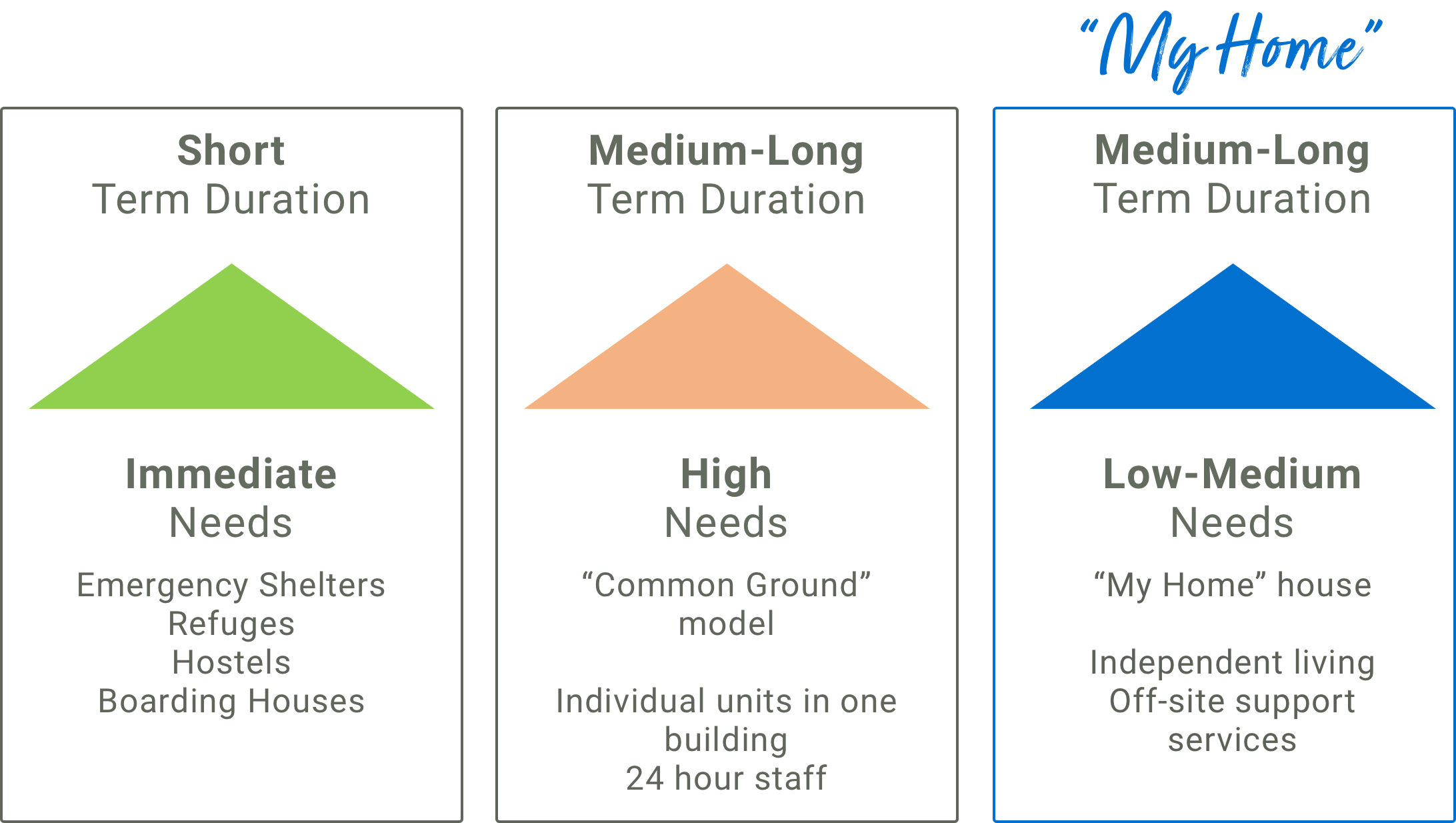Why Are We Doing This?
The Problem
We know there are at least 9,000 people experiencing homelessness on any night in Western Australia. There a many more people who we don't know are homeless. Each year, WA’s specialist homeless services assist over 24,000 people.
These people could be rough sleeping on the streets and in parks, living out of their car, couch surfing with family and friends, living in shopping centres, camping in the bush or staying in squats, boarding houses, temporary hostels and lodges.
Refuges, halfway houses and emergency shelters are only a temporary day-by-day support for homeless people. They are not a home.
There is an urgent need for permanent, low-cost housing to enable people who are homeless to get back on their feet and establish a decent quality of life. They need a place that they can call "My Home".
The high cost of rental housing and dire shortage of affordable housing has made the need for a supply of homes for people who are homeless all the more urgent.
9,000 homeless people.
Tonight.
In Western Australia.
The Urgent Need for Housing
In Australia, there is an unprecedented growth in the number of people experiencing homelessness. This could be through personal circumstances but the increasing costing of housing is making it more difficult to rent in the private market.
Financial stress occurs when the cost of accommodation is 30% or more of the individual’s income. People on Keystart or other social benefits simply cannot afford to pay private market rent.
The Western Australian Government and the Western Australian Alliance to End Homelessness have both released ten year strategies to reach zero homelessness in our communities.
Both have identified affordable, accessible housing as the number one priority needed to achieve zero homelessness. However, we are still not seeing an increase in housing supply for homeless people.
Zero homelessness in a community is when the number of people moving on from a homeless situation is equal or greater to the number of people becoming homeless.
We cannot wait for, or expect, the Government to do the job of providing housing alone. We need to come together in a joint effort using the assets, capital, expertise and strategic thinking of the community as well as research and lessons learned from overseas and other Australian states to increase rapidly housing supply.
We have an abundance of vacant unused land in the Perth metropolitan area and regional centres, such as land owned by statutory authorities, State and Federal Governments, local councils, the Church and other community organisations. This land could be put to good use.
In Australia, there is an unprecedented growth in the number of people experiencing homelessness. This could be through personal circumstances but the increasing costing of housing is making it more difficult to rent in the private market.
Investment in permanent housing is a key driver in enabling people to find employment, undertake training and regain a self-sufficient life.
A Real Solution To Housing Homeless People
Housing First
The Housing First model is widely accepted in Europe, USA, Canada and Australia as a best practice response to reducing homelessness.
Communities in Finland, Canada and the US have achieved, or are on their way to achieving, Zero Homelessness.
Housing First works on the premise that if someone has permanent, secure, safe housing that they can call "my home", then chances of progressing to an independent and dignified quality of life are significantly increased.
Delivering successful results
Precedents show that Housing First has around 80% success rate, i.e. people do not regress to homelessness, as well as significant reductions in clients presenting to emergency departments and dealing with the justice system.
Statistical evidence confirms that visits to emergency medical centres and other crisis services are dramatically reduced when people have permanent housing, which in turn reduces the costs of providing these services.
In Australia, Housing First projects have demonstrated that providing housing to homeless people can save the State government $13,000+ a year per person in government-provided services.
Housing First makes it easier for support service agencies to establish a relationship when a person has a fixed address, and to assist with:
- Finding employment
- Undertaking training
- Managing medical and social issues
- Rebuilding personal dignity and self-worth
- Regaining a self-sufficient life.
The State Government and WA Alliance to End Homelessness are supportive of the Housing First model.
Three Types of Homeless Accommodation
Zero Homelessness
We accept that we cannot eliminate homelessness whilst there are social issues at play in our communities, such as domestic violence, personal financial crisis, inadequate mental health care, family breakdown, drug and alcohol addiction. However, we can achieve Zero Homelessness by ensuring that people can access housing and support services as soon as they become homeless or are at risk of homelessness.
In essence, Functional Zero Homelessness is when the number of new people using homelessness services in a community is less than or equal to the number of people who exit homelessness through being housed, leaving the community, becoming self-sufficient or dying.
The intention is that by using real-time data to track and improve performance and by involving the community in solutions to end homelessness, organisations will adopt those practices that support the most efficient allocation of resources to achieve more effective, efficient results.
Zero Homelessness Resources
Community Solutions: Approach To Homelessness
Alliance to End Homelessness (AAEH): The A To Z of Homelessness
Australian Housing and Urban Research Institute (AHURI): What Is Functional Zero?
